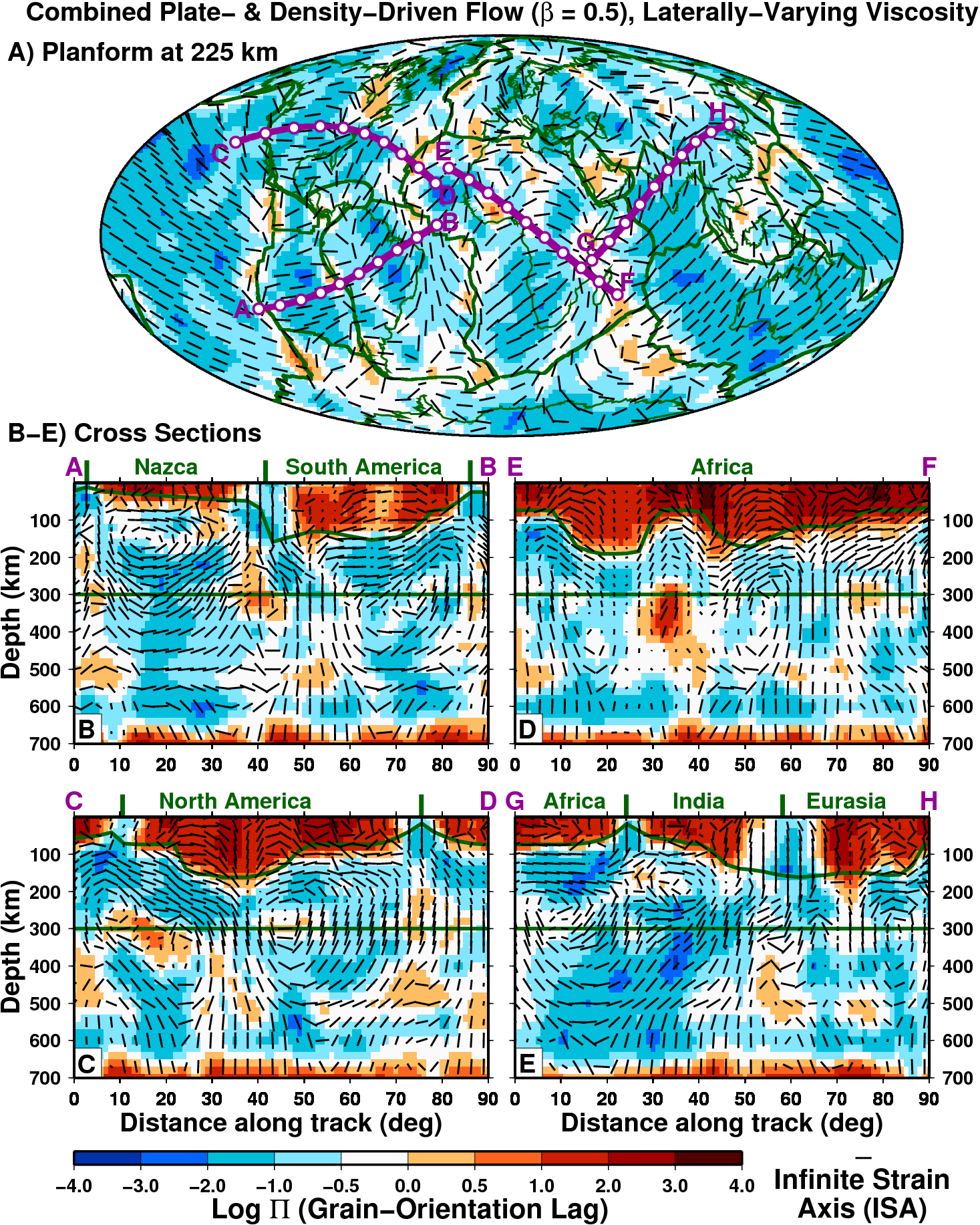Viscous Flow in the Earth's Mantle


In our recent paper [Conrad, Behn, and Silver, 2007, citation below] we calculated mantle flow driven by mantle densities inferred from (1) the S20RTSb seismic tomography model of Ritsema et al., [2004] and (2) the NUVEL-1A plate motions [DeMets et al., 1994]. We then used observations of seismic anisotropy to constrain the best combination of these two (density-driven and plate-driven) flow fields. The result is a global model of viscous mantle flow. The top left figure shows the velocities of the flow field both at the surface (plate motions) and in cross section against the density field. The top right figure shows the upper mantle infinite strain axis (ISA) and PI parameter (both defined by Kaminski and Ribe [2002]), which can be used to infer anisotropic fabric. Below are downloadable files that contain the velocities, infinite strain axis, and PI parameter, as a function of location within the mantle.
UPDATE (January 2008): We have improved our method for estimating the ISA and PI parameters (by improving the precision of our code). The improved results provide a smoother ISA field, and thus slighly lower values of PI throughout the asthenosphere. The results below (ISA and PI) were calculated using this improved code. Also, we have replotted some of the key figures from the JGR paper:
Figure 4
Figure 5
Figure S1
Figure S2
Updated Supplementary README Text (for figures S1 and S2)
Global Mantle Flow Model for Download
The files below provide the global mantle flow model that is described in the JGR paper. Included are the temperature, viscosity, velocity, and stress fields for the entire mantle at two time steps: Time step 0 is for the present day, and time step 10 is for a time 3.5 Million years from now. These files allow us to determine the present-day flow field and how it is currently changing with time (its first time-derivative). The details of how the flow field was calculated are described in the JGR paper.
Location/Temperature/Viscosity:
s20rtsb.inexv.comb.0.xyzt.gz Time Step 0 (Gzipped Ascii File, 6.7 MB)
s20rtsb.inexv.comb.10.xyzt.gz Time Step 10 (Gzipped Ascii File, 7.9 MB)
Format (5 columns):
1. (colatitude (radians measured from the north pole)
2. longitude (radians)
3. radius (measured as fraction of the earth's radius: CMB=0.55, 1.0=Surface)
4. temperature (relative measure between 1 at the CMB and 0 at the surface)
5. viscosity (multiply by 0.5e21 Pa s to make dimensional)
Flow Velocities:
s20rtsb.inexv.comb.0.v.gz Time Step 0 (Gzipped Ascii File, 9.6 MB)
s20rtsb.inexv.comb.10.v.gz Time Step 10 (Gzipped Ascii File, 9.6 MB)
Format (3 columns, dimensionless units - divide by 2018.9 to convert to cm/yr):
1. Theta (Positive Southward) Velocity
2. Phi (Positive Eastward) Velocity
3. Radial (Positive Upward) Velocity
Stress Field:
s20rtsb.inexv.comb.0.str.gz Time Step 0 (Gzipped Ascii File, 19.7 MB)
s20rtsb.inexv.comb.10.str.gz Time Step 10 (Gzipped Ascii File, 19.7 MB)
Format (6 columns, dimensionless units - multiply by 12.322 to convert to Pa):
1. Sigma_radial_radial
2. Sigma_radial_phi
3. Sigma_radial_theta
4. Sigma_phi_phi
5. Sigma_theta_phi
6. Sigma_theta_theta
Time Dependence: s20rtsb.inexv.time.gz Time Step File (Gzipped Ascii File, 1 KB)
Format (5 columns)
1. Step Number
2. Total Elapsed Time (dimensionless units - multiply by 1.286E06 to convert to Myr)
3. Time for Step (dimensionless units - multiply by 1.286E06 to convert to Myr)
4. Total Elapsed Wall Clock Time (s)
5. Wall Clock Time for step (s)
Prediction of Anisotropic Crystal Fabric
The strain deformations caused by mantle flow will deform olivine aggregates into a lattice-preferred orientation (LPO), generating a seismically anisotropic fabric. We use the above flow field to predict LPO for the asthenosphere by implementing Kaminski & Ribe's [2002] scheme for estimating crystal fabric from a given flow field. This method (which differs from the DREX calculation), uses the infinite strain axis (ISA, the orientation of the long axis of the finite strain ellipsoid after an infinite amount of uniform strain) to approximate the LPO. Because the ISA can be estimated from an instantaneous flow field, time-dependent strain-accumulation is not necessary. However, if the flow field varies too rapidly in space or in time, then the ISA~LPO approximation is not valid. To determine where this approximation is valid, Kaminski & Ribe [2002] introduced the PI parameter that compares the rate of ISA developement with the rate of ISA rotation in the flow field. Where PI > 0.5, then the flow field rotates olivine crystals away from the ISA faster than the ISA can develop. In this case, the ISA is a poor approximation of LPO. Thus, it is important to make sure that PI < 0.5 before comparing predictions of ISA with observations. Fortunately, we have found that PI < 0.5 throughout most of the asthenosphere in most cases.
Our code for calculating PI and ISA from the above flow field is here:
calcpi fortran code: [calcpicode.tar.gz] (gzipped, tarred, directory, 10.6 KB)
This code operates on the mantle flow field that is downloadable above. See the README file within. The code is cabable of outputting several variables from Kaminski & Ribe's [2002] formulation, but the most important are PI and ISA. These fields, calculated using the calcpi code and the input flow model above, are given below:
Infinite Strain Axis: [s20rtsb.inexv.comb.10.ehat.gz] (Gzipped Ascii File, 6.8 MB)
Format (3 columns):
1. Theta (Southward) Component
2. Phi (Eastward) Component
3. Radial (Upward) Component
Infinite Strain Axis: [s20rtsb.inexv.comb.10.ehat.kmz] (Google Earth Format, 3.0 MB)
Courtesy of Andreas Wuestefeld, University of Montpellier (France)
NOTE: This file contains the predictions of ISA that were presented in the JGR paper (not the new ISA results above)
PI Parameter: [s20rtsb.inexv.comb.10.pi.gz] (Gzipped Ascii File, 3.1 MB)
Format (1 column):
1. PI value (dimensionless)
Citation
Please reference the following paper if you use the above flow model, anisotropic fabric prediction, or code:
Conrad, C.P., M.D. Behn, and P.G. Silver, Global mantle flow and the development of seismic anisotropy: Differences between the oceanic and continental upper mantle, Journal of Geophysical Research, 112, B07317, doi:10.1029/2006JB004608, 2007.
[online version]
[reprint]
[auxiliary material]